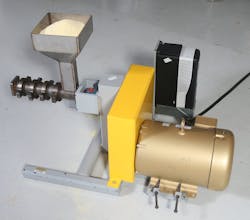NASA commissioned Purdue University researchers to develop a lightweight extruder that could be used to process various grains, including soybeans, during a mission on Mars. Many puffed cereals and snacks, as well as pastas, are made using extrusion.
Purdue’s prototype device uses friction to heat and cook the soybeans, and then separates oil from the soybeans. The resultant rope-like substance can be dried to make flour or combined with other products to make pastas and snacks. The soybean oil can also be used for salad dressings or other cooking needs.
“NASA wanted a way to process food grown on Mars because it is so expensive to ship food there—something like $200,000 per kilogram,” said Martin Okos, a professor of agricultural and biological engineering and one of the project’s leaders. “The biggest challenge we faced was scaling down, but we developed an extruder that is down to about 60 lb. NASA would like an extruder to be 100 times smaller, so more research is needed to reach that goal.”
Before the extruder makes its debut on the red planet, however, it has found a more important use boosting food production capacity in Niger, Senegal, and Kenya. After working on the NASA prototype, Okos and graduate student Amudhan Ponrajan modified the extruder to work with other types of grains and legumes, including pearl millet, teff, corn, rice, wheat, sorghum, chickpeas, and lentils, which are more widely grown in developing countries.
Those foodstuffs can be milled/ground, mixed with water, and pushed through the extruder, which uses a screw to force the product through a channel where friction heats and cooks the grain, just like its Martian counterpart. And the output can be dried and ground into flour that, when mixed with water, results in an instant porridge.
Many traditional African porridges made from those grains and beans can be labor-intensive to make. In urban areas, consumers look for more convenient alternatives, but the only ones in market are imported and expensive. The extruded grain products can be dried and packaged as “just-add-water” versions of traditional meals.
“With this equipment, we think it people there will to scale up production and bring down prices significantly, says Moustapha Moussa, a Purdue doctoral student in food science who is one of the leaders of the effort to introduce this technology to African markets.
In West African cities, labor-intensive efforts to make products like couscous could be drastically shortened. It can take a crew of 10 women in Niger an entire day to create 30 kg of couscous using current methods. With the extruder, the same crew could make 300 kg in a day.
The modified extruder for Africa was designed to be relatively inexpensive. Large-scale extruders in U.S. facilities cost up to $200,000 and can process hundreds of kilograms per hour. The Purdue-modified extruder produces 35 kg hour, but costs only $20,000.
In addition to cost reductions, the extruder had to be modified to work with various crops grown by African farmers. The speed and size of the screw components in the device determine how much heat is created through friction. Soybeans are high in oil content, so they need more friction to cook them. Millet, sorghum, and maize are low in oil, so the same amount of friction would burn those grains.
Moussa, Ponrajan, and Bruce R. Hamaker, distinguished professor of food science at Purdue, are working with entrepreneurs in Senegal, Niger, Kenya, and other countries, teaching them how to use the device and secure funding to purchase them. They also are testing the market, which so far indicates consumers will accept the porridges and other products that come from the extruder. They also may be willing to pay more for them than for traditional porridges, though the extruded products would cost less than imported instant products.
More market research is needed, and researchers are working to identify formulations that will let the extruder be used with more grains. The device meant to feed astronauts on years-long journeys to Mars may one day set off into space, but its impact will likely be felt on Earth much sooner.


